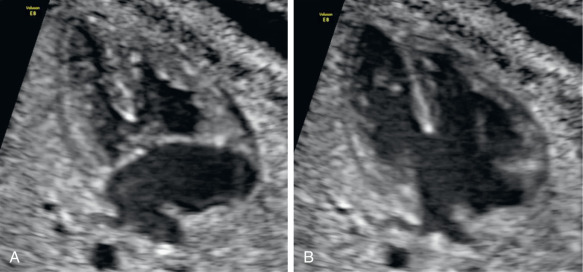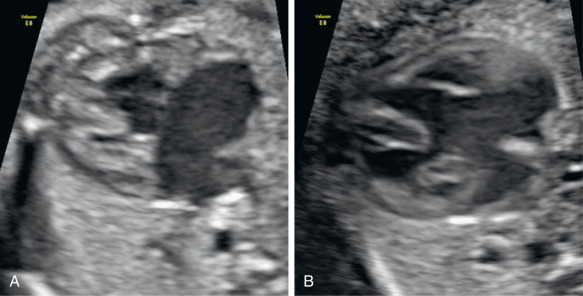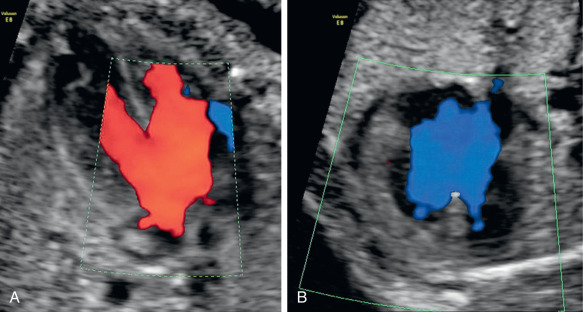Abstract
Atrioventricular septal defect (AVSD) is one of the most common congenital heart diseases diagnosed in the fetus, with an overall poor prognosis. Prenatal diagnosis using the four-chamber view is easy in complete forms and more challenging in partial AVSD. AVSD is highly associated with chromosomal abnormalities (particularly Down syndrome) and more complex syndromes (cardiosplenic syndromes). An extensive workup is required to identify associated chromosomal abnormalities and other structural abnormalities. Follow-up every 4 to 6 weeks is recommended to rule out atrioventricular valve insufficiency, which indicates a high risk of hydrops. In the absence of hydrops, the obstetric management should not be changed. Isolated balanced AVSDs and partial forms are associated with a good prognosis.
Key words
atrioventricular canal, endocardial cushion defect, complete/partial, balanced/unbalanced
Disease
Definition
The term AVSD covers a spectrum of CHDs characterized by a common deficient separation in the atrioventricular junction. AVSD is also called atrioventricular canal or endocardial cushion defect because this CHD derives from an abnormal fusion of the endocardial cushions in the first stages of pregnancy.
Prevalence and Epidemiology
The estimated incidence of AVSD ranges from 0.24 to 0.31 in 1000 live births. AVSD accounts for 15% to 20% of all prenatally diagnosed CHDs. In the fetus, this CHD can be considered a complex anomaly because it is frequently associated with chromosomal abnormalities and other CHDs, which may influence a high elective termination rate and help explain that the incidence of AVSD is lower in postnatal series (4% to 5% of all CHDs in newborns).
Etiology and Pathophysiology
The etiology is multifactorial. AVSD is associated with chromosomal abnormalities in 35% to 50% of cases, of which 75% are trisomy 21. It can also be associated with cardiosplenic syndromes (30% to 40% of cases). In such cases, the risk of associated complete atrioventricular block and other CHDs is also high.
There are two forms of AVSD:
- 1.
Complete ASVD is characterized by a common atrium, a single atrioventricular valve (usually with five leaflets), and a wide defect in the membranous portion of the interventricular septum. In most cases, the two ventricles are of normal size, and the defect is defined as a balanced AVSD. If one of the ventricles is hypoplastic, the AVSD is defined as unbalanced .
- 2.
Ostium primum atrial septal defect (ASD) is also called partial or incomplete AVSD . There is an ASD, but part of the ventricular septum is filled, and the atrioventricular valvular orifices are divided into two distinct valves.
Manifestations of Disease
Clinical Presentation
A newborn with AVSD may present with a mild degree of central cyanosis related to the bidirectional shunting at both atrial and ventricular levels. The risk is related to the degree of elevated pulmonary vascular resistance at birth. In infants with complete AVSD and a sizable interventricular component, congestive heart failure is likely to develop within the first few months of life as pulmonary vascular resistance declines. However, cardiac failure may occur much earlier if there is significant regurgitation of the common atrioventricular valve or ventricular imbalance. In patients with complete AVSD and a small interventricular component with minimal valve regurgitation, or in patients with a partial ASD, cardiac failure is rare, and clinical symptoms may be minimal or absent in infancy and childhood.
Imaging Technique and Findings
Ultrasound.
AVSD is the CHD most frequently diagnosed in the fetus because it always alters the four-chamber view. The key diagnostic feature in complete AVSD is that the heart loses the normal aspect of the atrioventricular plane because of the presence of a common valve; the atrioventricular septum is absent, and the common atrioventricular valve appears as a single straight line during systole. There is also a typical image of a single, common atrium owing to the absence of atrial and perimembranous interventricular septa ( Figs. 76.1 and 76.2 ). Color Doppler illustrates the common atrioventricular diastolic filling, with a characteristic H -shaped appearance ( Fig. 76.3 ). Color Doppler may also show whether the common valve is insufficient. In such cases, the velocity of the retrograde valve flow can be measured with pulsed wave Doppler ( Fig. 76.4 ).













